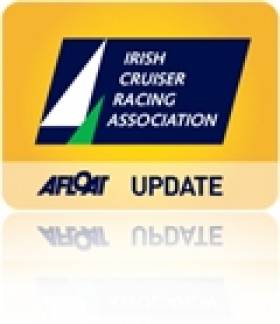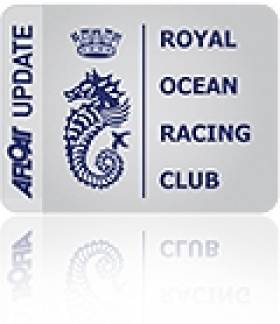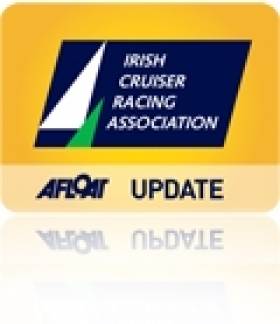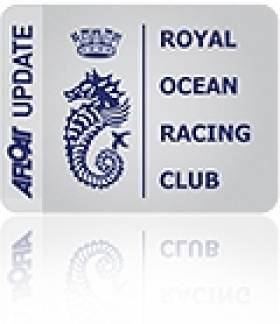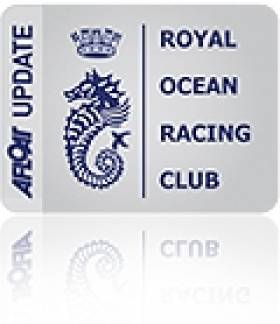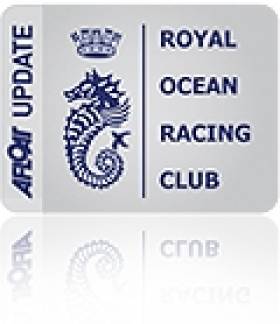Displaying items by tag: Commodores Cup
#commodorescup – The two managers behind both of Ireland's Commodore's Cup victories have 'stepped down' from the job, an executive meeting of the Irish Cruiser Racer Association (ICRA) heard last month. A successor for both Barry Rose of Royal Cork YC and Fintan Cairns of the Royal Irish YC is being sought by the cruiser–racer body to defend the international title next season on the Solent. The midlands meeting heard ICRA's shore management performed 'a very important role as a focal point and coordinator for the whole team process' .
It was imperative, according to the meeting, chaired by Howth YC's Nobby Reilly, that ICRA would continue to perform that role in the future. The Portlaoise gathering of April 20th also heard of the necessity to start the process of 'achieving team or team selection' to challenge in 2016. The quest for team sponsorship also needs to be underway.
Separately, Royal Cork's Commodore's Cup team captain Anthony O'Leary has told Afloat.ie of his 'fervent hope' to be involved with the 2016 defence of the Cup that he has won twice. However, his Ker 39, Antix has been sold to Sweden and this year O'Leary and his Antix crew are campaigning offshore in the renamed Ker 40, Catapult. They take in RORC's Myth Of Malham this week before June's Dun Laoghaire to Dingle race. They're both warm–up races for the season's big one in August, the sell–out Fastnet race.
The 2016 Commodore's Cup changes will see the reintroduction of a small boat for the team competition next year it has also been announced. The Royal Ocean Racing Club (RORC) has agreed to a number of changes that they say will have 'a positive impact' on the number of teams taking part in the event held at Cowes, Isle of Wight between 23 and 30 July 2016.
The first is the requirement of every team to have a small boat with a rating between 1.000 and 1.049. 'Many teams in the last event believed that it was hard to be competitive without having three boats that were close to the top of the allowable rating band, as was the case of last year's winning Irish team,' said RORC CEO, Eddie Warden Owen.
As the Irish Times Sailing Column reports, lowering the rating band to 1.000 will make it easier for J109s to enter, to include boats like the JPK10.10, A35 and the new Sunfast 3200, and reduce the cost of competing.
Read also: How Ireland won the Commodore's Cup and Anthony O'Leary, Sailor of the Year
#royalcork – Four years and seven months may seem an eternity for many people. Yet if you're in the business of planning major club and sporting events, particularly where there's a significant international context, then four years and seven months is but the blinking of an eye. In 2020 - in four years seven months and 22 days to be precise - the Royal Cork Yacht Club will be 300 years old. W M Nixon takes a look at life in and around a very remarkable and undoubtedly unique organisation as it moves steadily towards its special date with destiny.
The world's oldest yacht club is in good health, enjoying a growing membership with an increasing and very distinguished international flavour. And it already has a proven track record in marking significant birthdays. Back in 1969-70, led by Clayton Love Jnr as a visionary and energetic Admiral, the club celebrated its Quarter Millennium with a two year sailfest which included finishing a Transatlantic Race, starting or finishing several other major offshore races, staging several national and international championships, running a race week, and co-ordinating an especially successful Cruise-in-Company by a large fleet from Cork Harbour to Glengarriff on Bantry Bay.
In this galaxy of sailing events, the Royal Cork's traditions of volunteerism and competitive involvement afloat was much in evidence. If Crosshaven sailors weren't running the show afloat and ashore, then they were likely to be competing in it afloat, and almost inevitably featuring in the frame.
So in all, those staging the Quarter Millennium set a standard which their successors planning towards 2020 - which is additionally distorted by being an Olympic year - will find difficult to match. For they'll be doing so in a very changed world in which newly re-born regattas and special events are crowding the national and international calendar, while the undoubted international change of attitude in favour of events in warmer climates means that a sailing club on an island well north in the Atlantic will have to try that much harder to attract the kind of boats and sailors its major and unprecedented anniversary merits.
But far from being fazed by the prospect of what needs to be done for 2020, the Royal Cork YC relishes living life to the full in the here and now. During the past year and more, the Crosshaven club has been led with such enthusiasm and exemplary energy afloat and ashore by Admiral Pat Lyons that at the National Sailing Awards in Dublin in March, it was announced that the Royal Cork was the winner – for the sixth time - of the annual ISA/Mitsubishi Motors "Sailing Club of the Year" trophy, which dates back to 1979 but has been firmly under the wing of Mitsubishi Motors since 1986.
However, although the announcement was made at a national gathering, the essence of the Club of Year accolade is that the winning club and its members should be honoured in their own clubhouse in its own very specific local setting. Which sounds straightforward enough. But when you get into the world of high-powered sailing types and the challenge of trying to get many fast-moving targets into one place at the one time, it makes herding cats seem like a doddle. So it wasn't until this week that a date was finally found on which most of the key players in the Royal Cork scene would be in and around their clubhouse. But it was well worth the effort and the wait – the ceremony provided us with the very purest spirit of Royal Cork.

Crosshaven in high summer. Around Cork Harbour, the interaction between sea and land seems much more comfortable than anywhere else in Ireland. Photo: Robert Bateman

At this week's Club of the Year awards ceremony for the Royal Cork YC were (left to right) W M Nixon, (chairman of the adjudicators), David O'Brien (ISA Board Member), Pat Lyons (Admiral RCYC), Frank Keane (Chairman Mitsubishi Motors), and Billy Riordan (CEO Mitsubishi Motors). Photo: Robert Bateman
Such is the enthusiasm of this remarkable club at its immaculately-maintained and hospitable clubhouse/marina complex in Crosshaven that you'd think they must be one of the newest in the land. But they went at their sailing in 2014 as though it was Tricentenary time already, running a nine-month club sailing programme with an extensive junior training input, and in addition staging the ISAF Women's International Match Racing Worlds in June.
Then in July they hosted a successful Cork Week which – apart from providing great racing for all competitors – showcased the new Irish International Commodore's Cup Team for the first time, an auspicious debut as the team went on to win the Commodore's Cup, with Royal Cork's Anthony O'Leary playing a key role throughout.
Anthony O'Leary also won the British IRC Opens and the Irish Helmsmans Championship, and then for good measure he took the 1720 Nationals as well. Meanwhile, RCYC's Harry Durkan took the junior title, while clubmate Seafra Guilfoyle was garlanded with international success in the Lasers.
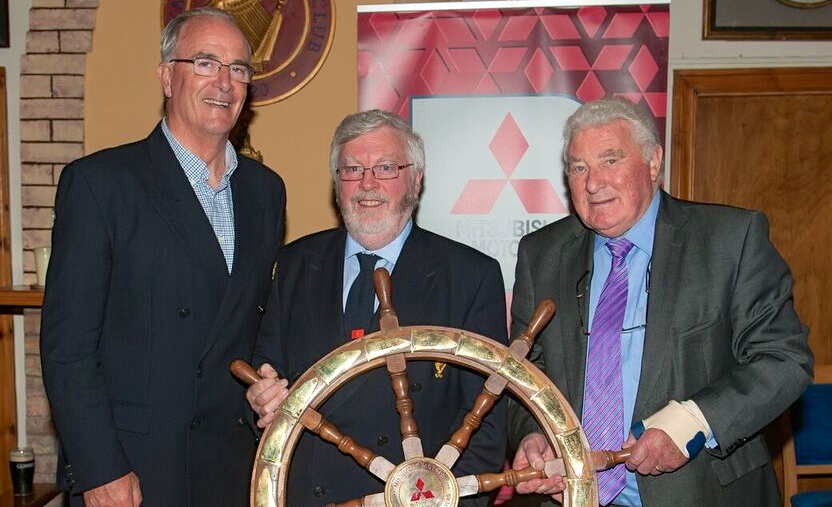
Commodore's Cup Team Captain and Afloat.ie Sailor of the Year 2014 Anthony O'Leary with RCYC Admiral Pat Lyons and Frank Keane of Mitsubishi Motors. Photo: Robert Bateman
On the cruising front, it was to be announced in due course that during 2014, the voyaging by Royal Cork YC longtime member Neil Hegarty in his 34ft sloop Shelduck on both sides of the Atlantic, and across it too, had been awarded the premier trophy of the Irish Cruising Club, the Faulkner Cup. As it happens, the skipper of Shelduck was one of the few conspicuous absentees from this week's ceremony, for the very good reason that he's already away cruising in America. But the ICC was well represented by Vice Commodore Dan Cross of Crosshaven, and also by former RCYC Admiral Paddy McGlade, who in 2014 organised the Cruising Club's very successful 85th Anniversary Cruise-in-Company from Crosshaven to Glengarriff with an exemplary lightness of touch.
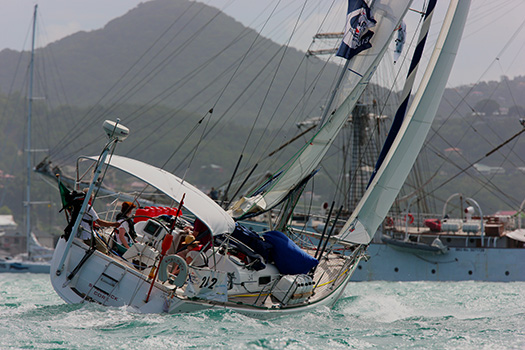
Neil Hegarty of RCYC bringing his Dufour 34 Shelduck into port at the conclusion of a Transatlantic passage during his award-wnning 2014 cruise.
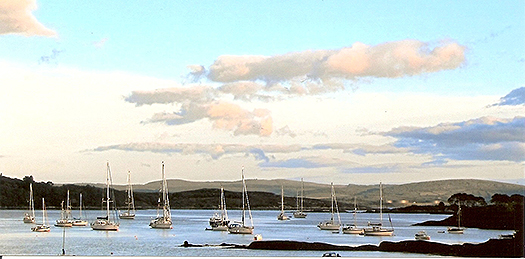
Part of the Irish Cruising Club's fleet in Glengarriff during the Cruise-in-Company organised by Royal Cork's Paddy McGlade
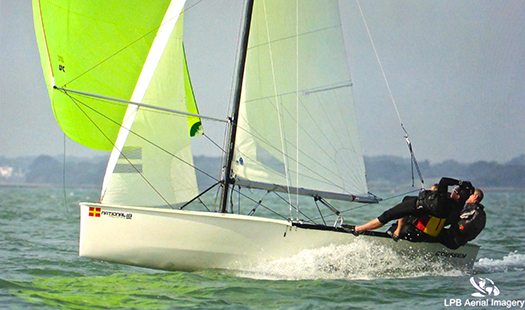
Odyssey, the prototype of the new National 18 whose development has been largely driven by the Cork Harbour division of the class.
Back home meantime, the Royal Cork's busy and long-established fleet of National 18s played the key role in developing the new National 18 which is currently being launched to popular acclaim, and two of the key figures in what amounts to a remarkable community movement – Dom Long and Tom Dwyer – were enthusing, and quite rightly too, about the new boats in the RCYC at this week's gathering.
At the height of the season, the Royal Cork was one of the clubs leading the movement in putting new life back into the established two-person dinghy classes. And looking to the future this summer, the club's plan to revive Dinghy Week as a four day event in August already shows every sign of success, emphasising the presence of an ongoing sense of the continuity of Cork Harbour sailing, something which in its turn is reinforced by a healthy and dynamic interaction with the community within which this great club is set.
There is no doubt that Cork is different. It interacts with the sea in a much more comfortable way than anywhere else in Ireland, and boats are everywhere about Cork harbour, whether nestling in a mudberth, or lying to a sheltered mooring, or berthed in one of the sparkling new marinas which seem to be springing up in every part of the harbour as the economy gets going again.
As for trying to capture the essence of the Royal Cork, the fact that the Club of the Year trophy adjudication force us to take a still from a moving film – often a very fast-moving film – only serves to emphasise how successful the RCYC is at so many levels.
Thus its exceptional successes in 2014 have now been clarified in proper order and full detail. But already they've moved well into 2015. Cork sailors were very much to the forefront in the recent major Laser event on Lough Erne, with young Nicholas Walsh the pace-setter. And of course the indefatigable Anthony O'Leary is already the Afloat.ie "Sailor of the Month" for April after his clean run of success with the new Ker 40 Antix, ex-Catapult, in the Solent.

Party time in the Royal Cork after the formal presentation ceremony. The trio at right are ICC Vice Commodore Dan Cross and Sally and Anthony O'Leary. In classic Crosshaven style, Dan and Anthony have been friends and neighbours ashore and afloat since childhood. Photo W M Nixon
He finds her a fascinating boat after his more conservative Ker 39, the silver Antix of 2006 vintage. Whereas the older boat was quite docile to steer, as she had twin wheels complete with footbrace pads for the helmsman, the new boat is more like a giant dinghy with a widow-maker of a tiller, and the helmsman having to be hyper-fit to keep himself in place on that very wide cockpit. The word from Skipper O'Leary is that the red Antix is a dream to helm to windward, but steering her on a hairy run can be....well, very hairy indeed.
That such things could be discussed with the man himself was all of a piece with the remarkable mood in the Royal Cork Yacht Club, where the conversation turned with equal ease to the new Cool Route. This is the cruising trail from southwest Ireland to northern Norway which is being developed in Cork Institute of Technology by RCYC member John McAleer with the club very much on board as an international marketing partner.
As to just how this will go, we can only think for now that if they could just somehow bottle the communal can-do spirit of the Royal Cork and then get it to work its magic in all the other prospective ports along the Cool Route, then they really would have a winner. Meanwhile, congratulations to the Royal Cork Yacht Club, ISA/Mitsubishi Motors Sailing Club of the Year for 2015.
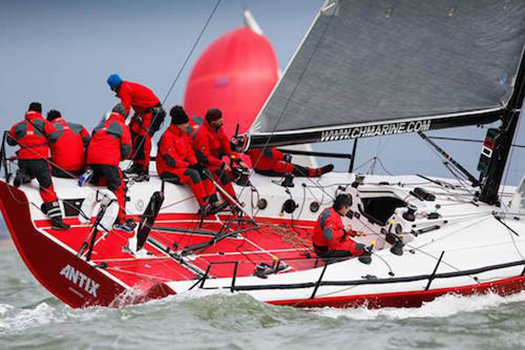
A different animal altogether. After the compact and comfortable two-wheel arrangement on the silver veteran Ker 39 Antix , the new tiller-steered Ker 40 Antix may provide a more direct feedback sailing on the wind for helmsman Anthony O'Leary, but hectic downwind sailing can become very hairy indeed.
New Format Commodore's Cup Unveiled for 2016
#comodorescup – Irish defending champions of the Commodore's Cup will face a new format event next year following new rules unveiled this morning by London organisers, the Royal Ocean Racing Club. The Brewin Dolphin Commodores' Cup is the Royal Ocean Racing Club's (RORC) biennial flagship event for national teams with amateur crews. The international offshore regatta comprises a tough mix of inshore and offshore racing and is an intense seven-day programme that pits three-boat teams against one another to accrue overall team points.
Ireland has twice won the Cup in 2010 and 2014 both under the captaincy of Afloat Sailor of the Year Anthony O'Leary of Royal Cork Yacht Club. Read how Ireland won the Cup here.
For the next edition, The RORC Committee have agreed to a number of changes that will have a positive impact on the number of teams taking part in the event held at Cowes, Isle of Wight between 23 and 30 July 2016.
The first is the requirement of every team to have a small boat with a rating between 1.000 and 1.049. "Many teams in the last event believed that it was hard to be competitive without having three boats that were close to the top of the allowable rating band, as was the case of last year's winning Irish team," commented RORC CEO, Eddie Warden Owen.
"Lowering the rating band to 1.000 will make it easier for J109s to enter, to include boats like the JPK10.10, A35 and the new Sunfast 3200, and reduce the cost of competing. This group of boats will have their own starts, but if a team has more than one boat within this rating band, and it is possible to have three 'small' boats, it will have to nominate which boat will compete in this division. The maximum rating is still 1.230 and there has been no change to the rule that only allows one boat in each team with a rating between 1.150 and 1.230," continues Warden Owen.
The second change is the addition of an extra professional sailor to each team but without stipulation which boats they shall sail on. The exact wording is as follows: The crew of each three-boat team shall include no more than 6 Group 3 Sailors. These Group 3 sailors may sail on any boat or boats in the three-boat team however crews cannot change after the Final Crew List has been submitted except as stated in NOR1.7.2.
"The thought was that many boats who have aspirations to compete in such an event, race with people who work in the marine industry and by virtue of their job, are regarded under the ISAF eligibility rules as Group 3 professionals. Whilst it should reduce the need for owners to make wholesale changes to their crew just to fit in with the event rules, it will give teams the opportunity to use the professional sailors to enhance weaknesses in the team overall. In theory you could load your weakest boat with six professionals if it was thought that this would strengthen the team as a whole," explains Warden Owen.
The other significant change is the removal of crew weight from the rules so that the boat sails with the crew number as shown on the certificate.
2015 Sailing Calendar Includes Two Bicentenaries & Ireland's Biggest Regatta At Dun Laoghaire
Irishsailing – After the remarkable across-the-board success of the 2014 Irish sailing season, 2015 will have to be very special indeed to be remembered with such enthusiasm. But it's a special year in any case, as two major sailing Bicentenaries – one in the Irish Sea, the other in the Solent – will have added and poignant meaning, as the Centenaries a hundred years ago could not be celebrated because of the First World War.
As for Irish sailing generally, life moves on, there are new sailors on the water, successful young sailors are graduating to the next stage of their rapidly developing careers, and established stars continue to plan fresh campaigns, for sailing is indeed a sport for life.
Then too, new fixtures successfully introduced in 2014 will require nurturing, tuning and encouragement if they are to fulfil their potential in the coming year, while at the same time there's always extra effort needed to give proper support to established fixtures, which have to live with the reality that they might wilt through being taken for granted. Both new and longer-established boat classes will need continued enthusiastic involvement, and our well-loved classics and traditional craft must be cherished and sailed, for lack of use is the real enemy of boats, whether old or new.
As for the major administrative initiatives introduced in 2014, they will need constant monitoring, but deserve full support from the sailing and boating community at large, for it was in response to a grass-roots initiative that the radical and very necessary reforms of the Irish Sailing Association were undertaken. Those appointed to undertake the root-and-branch reform of the national authority have done so with commendable dispatch, so it is now the duty of the rest of us to support their continuing efforts. And we can best do that by enjoying our boats and our sailing and time afloat in its myriad of interests, while encouraging others to do the same. W M Nixon outlines on what the coming year may bring.
One thing at least is certain for the coming season afloat during 2015 in most of Europe. It will not mark any significant sailing Centenaries. Instead, we are immersed in four years of remembering the Great War of 1914-1918 a hundred years on, with all the added twists of that period's longer historical narrative in Ireland. In such a context, it may seem frivolous to point out that sports like yachting have no great Centenaries to mark at all in 2015. But this minor off-screen fact is a reminder of the all-involving horror and obscenity of total warfare on an industrial scale. It obliterated anything like normal life.
Yet as recreational sailing had been going on in some sort of organised form for hundreds of years – albeit in a fairly rudimentary way in its earliest years in the 16th Century – there may well have been several important dates to be marked during the time of the Great War itself, but they were allowed to pass as there was no sport afloat, while civilian life ashore was very subdued.
And in Ireland, with the Troubles persisting for four years after the end of the Great War until 1922, the Bicentenary of the Royal Cork Yacht Club in 1920 was to be a muted affair – the official History of the Royal Cork Yacht Club (published 2005) tells us: "Plans for a special dinner to celebrate the club's bicentenary in 1920 had to be cancelled, probably because of the disturbed conditions in the country"
So the idea of celebrating the Centenary of the Royal Yacht Squadron in Cowes in 1915 at the height of the international war - other than in a rather solemn shorebound way - would have been unthinkable. But that in turn fuels the celebrations when the peacefulgood times roll again. Thus the Royal Cork Yacht Club, having been unable to celebrate its Bicentenary in 1920, went on to have a fabulous two-year Quarter Millennium celebration in 1969-70. And as the RYS couldn't have a proper party in 1915, there's no doubt that the up-coming Bicentenary in 2015 will be the nucleus of international sailing's megafest-of-the-year.
There are of course several clubs which pre-dated the Squadron when it was founded in 1815. And there are many whose members outshine the small membership of the RYS in the breadth and energy of their sailing. But for 2015, let's just acknowledge that the prestigious Squadron has been at the heart of sailing history for a very long time, while their clubhouse's location right on the Solent at Cowes is so central that when any great Solent-related events are under way, the Squadron is in the middle of the story.
Thus it was on the Squadron lawn that in July that the Irish team celebrated their epic Commodore's Cup victory at the end of July 2014. And it will be towards the Squadron and its Bicentenary that the fleet will be racing in 2015's west-east Transatlantic Race. And then it will be the firing of the cannons from the historic Squadron battery which will signal the start of the 46th Fastnet Race on 16th August 2015.
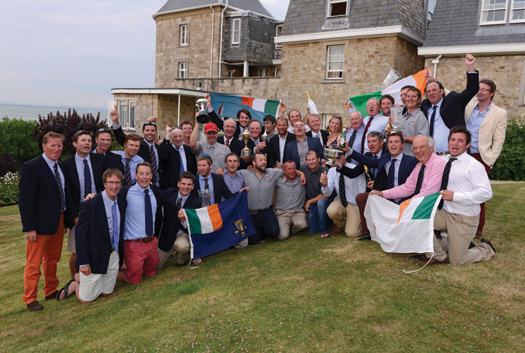
Party time at the Royal Yacht Squadron – the Irish team and their management gather to celebrate victory in the Commodore's Cup at the Squadron Castle in Cowes on August 1st 2014
There'll be many Irish boats involved, and the best-placed of them at the finish will be the winner of the Gull Salver, currently held by Martin Breen's Reflex 38 Lynx from Galway Bay SC, which was skippered to success by Aodhan FitzGerald in 2013's race. It's a coveted trophy, instituted to honour the memory of Harry Donegan of Cork and his famous cutter Gull, which was one of seven boats which inaugurated the Fastnet Race in 1925, and placed third. Since then, Irish Fastneteers have frequently been in the great race's top places, and best of all was in 2007 when Ger O'Rourke's Cookson 50 Chieftain out of Kilrush, sailing under the burgee of the revived Royal Western of Ireland YC, came sweeping in to the finish line at Plymouth to win the Fastnet Race
overall.
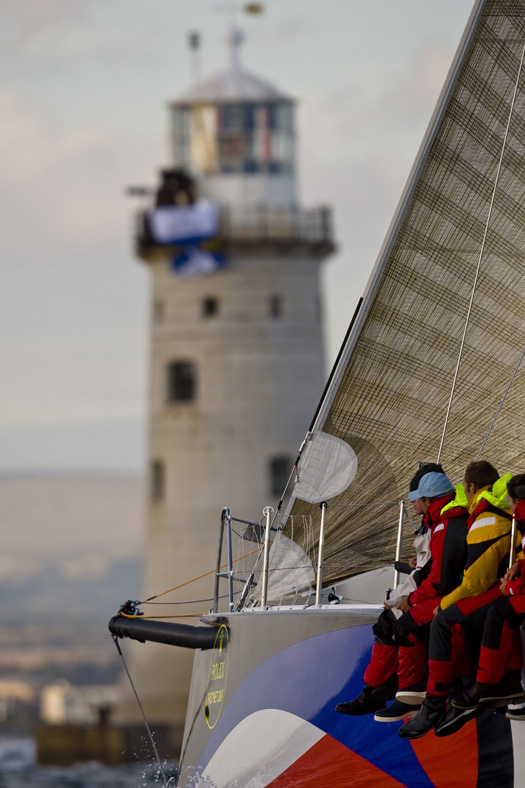
One of the greatest moments in Irish sailing history – Ger O'Rourke's Chieftain sweeps towards the finish line to become the overall winner of the Rolex Fastnet Race 2007. Photo: Rolex
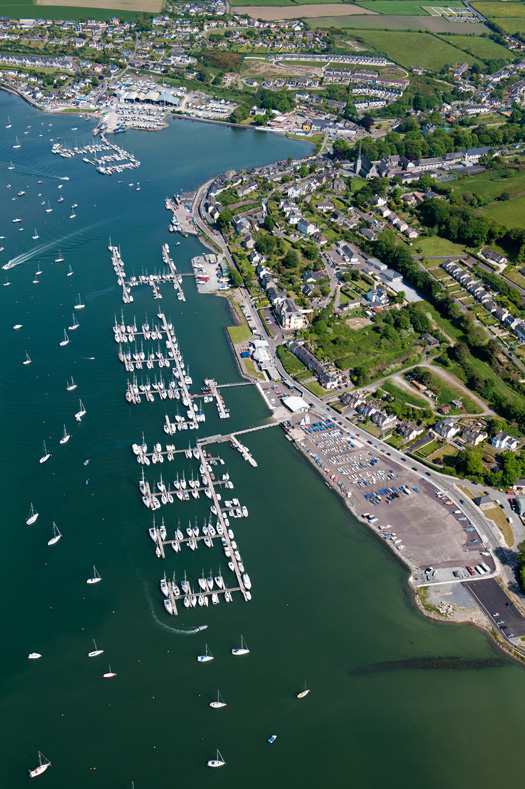
Just the spot for a great Tricentenary celebration - the very complete sailing facilities provided jointly by the Royal Cork Yacht Club and Crosshaven will become a world focus in 2020 with the Club's 300th anniversary. Photo: Bob Bateman
The realisation that 2015 sees this significant RYS Bicentenary is a timely reminder that the Royal Cork's Tricentenary is only five years down the line. They're five years which will be gone in a flash, and already behind-the-scenes moves are afoot to ensure that the national sailing programme will properly facilitate the extraordinary anniversary being celebrated in Crosshaven in 2020.
But meanwhile other Irish sailing centres have their own regular programmes to operate in the intervening four years, and in terms of numbers and scale there's no doubt the top event in Ireland in 2015 will be the biennial Volvo Dun Laoghaire Regatta from 9th to 12th July.
Anyone – and there were many - who took part in this unique "suburban sailfest" in 2013 will know that the VDLR has come of age. It's an event which is comfortable with itself while at the same time being always in development and evolution mode. Each staging of this remarkable Dublin Bay happening sees lessons being learnt and implemented even while the multi-class racing is under way on several courses. And in the two year gap before the next staging, the experience gained is closely analysed and the programme refined to further improve the sport in every area.
You get some idea of the sheer depth of racing experience in Dun Laoghaire by noting that the Chairman of the 2015 Committee is Tim Goodbody, with Martin Byrne as Vice Chairman while the Race Director is Con Murphy. And those three sailing megastars are just the peak of a mountain of race administration experience which is being drawn in from all over Ireland to ensure that the fleet of 400-plus boats gets the best sport possible.
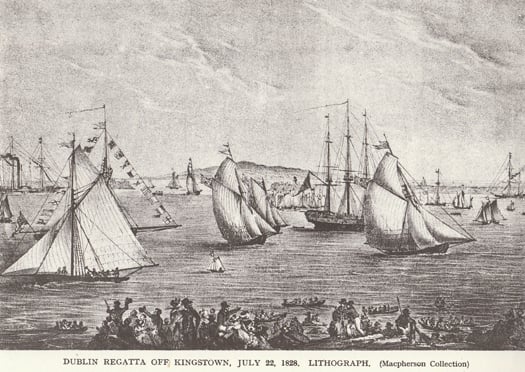
The first regatta in 1828 at the new harbour at Dun Laoghaire, which will be the setting for Ireland's biggest event in 2015, the Volvo Dun Laoghaire Regatta from 9th to 12th July.
While there'll be keenly participating boats from all over Ireland as well as Scotland, England and Wales, the setup of Dublin Bay being right on the city's doorstep means that it's the locals who would pose an administrative problem for a less experienced team. As the dates for the VDLR approached in 2013, the weather forecast steadily improved, and thanks to the Regatta's "extra long weekend" format, the sudden arrival of summer meant that a host of boats from the greater Dublin area came in as last minute entries, their owners and crews managing to scrape the extra day-and-a-half needed off work. It's a scenario which would put an overstretched administration off course, but the VDLR team took it calmly in their stride, and the result was a successful summer festival of sunlit sails and great sport, with maybe two thousand taking part.
This year there's a more structured cross-channel involvement, as the venerable Royal Dee YC in Cheshire has leapt to life to celebrate its Bicentenary. Founded as the Dee Yacht Club in 1815 with the end of the Napoleonic Wars, it didn't get the Royal seal until 1947, but nevertheless claims to be older than the RYS. With growing fleets in North Wales and the Mersey, it has put together a Bicentennial Royal Dee Irish Sea Offshore Championship linked closely to ISORA, which will bring the fleet across to Ireland to take in four offshore day races sailed as part of VDLR 2015.
Irish National Championships which will be part of the VDLR 2015 programme include the J/109s, the RS Elites, the Beneteau First 21s, and the Wayfarers, while the Leinster GP 14 Championship is also included as an integral part of the Regatta.
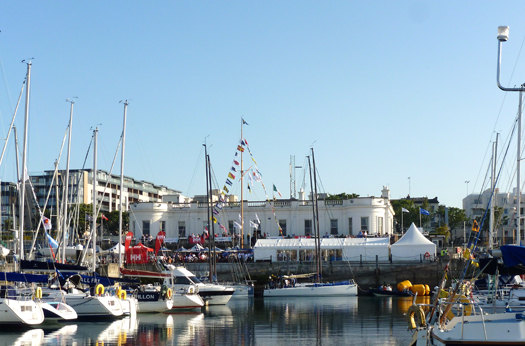
Party time in Dun Laoghaire – the Royal Irish YC during VDLR 2013. Photo: W M Nixon
As for Ireland's classic clinker-built vintage classes, one of the pleasantest surprises in VDLR 2013 was the large turnout of Mermaids, which had superb racing on the course area in the northwest corner of Dublin Bay. Despite having been born as the Dublin Bay SC Mermaid in 1932, this class of 17ft super-dinghies is no longer included in the regular DBSC programme owing to shortage of numbers for weekly turnouts. But it seems that as far as the VDLR is concerned, the Mermaid is now an event boat, and the fleets still thriving at other centres, together with some of the dormant Dublin Bay craft, bestirred themselves for the four days to enjoy good sailing for more than three dozen boats, something which is highly likely to be repeated in 2015.
The even more venerable Water Wags, founded 1887 with the current boats dating from 1903, continue to thrive in Dun Laoghaire, and the word is they expect to have at least twenty boats in action, while another wooden classic, the Mylne-designed 25ft Glen keelboat, is 50 years and more in Dun Laoghaire, and looks forward to having at least twelve boats racing in 2015.
All these specialized and historic classes are in addition to the numerous cruiser-racers which continue to be the backbone of Dublin Bay sailing. And while many of them will see the VDLR 2015 as a highlight of the year, in turning to consider the overall national programme, we find a sport which is shaking off economic recession to get on with an extraordinary plethora of local, national and international sailing events.
The problem is that most events of significance hope to locate themselves in the peak sailing period from late May to early September, so clashes are almost inevitable, and if you're interested in several different kinds of sailing, the overall choices can be bewildering in their complexity and logistical challenges.
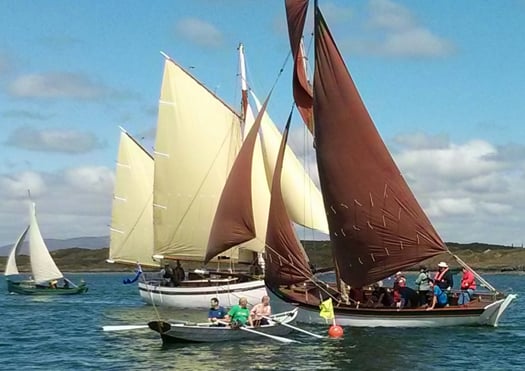
The Baltimore Wooden Boat Festival attracts an eclectic fleet – included here are a Shannon Gandelow, a West Cork Mackerel Yawl, the ketch Sile a Do, and an Heir Island Lobster Yawl (left).
For instance, the variety of events now available for the traditional and classic boats – usually but not necessarily under the Old Gaffer umbrella – would keep anyone busy for most of the summer. It starts with the Baltimore Wooden Boat & Seafood Festival from Friday 22nd May to Sunday 24th May, which you'd think very early
in the season for someone faced with fitting out an old wooden boat in Ireland's climate, but somehow they do it.
Then on the East Coast for the early summer Bank Holiday Weekend from May 29th to June 2nd, there's the Old Gaffer gathering in Dublin Bay at Poolbeg Y&BC with the annual race for the Leinster Trophy in the bay on Saturday May 30th, the event then morphs into the Dublin Port Riverfest in the Liffey on Sunday May 31st, and finally it all concludes with the race for the Asgard Trophy back in the bay on Monday June 1st.
The annual Lambay Race at Howth, a regular fixture since 1904, has seen its course becoming increasingly complex in modern times in order to satisfy the desire of modern racers for competition on every possible point of sailing. But in 2014, to celebrate the Centenary of the Lynch family's Echo, the venerable Howth Seventeens were sent on the traditional course north from Howth Harbour through the sound inside Ireland's Eye, then on round Lambay leaving it to port, and then back south inside Ireland's Eye again to the finish at Howth pierheads.
This was such an attractive proposition for Old Gaffers and Seventeens alike that on the day an extra Classics Division was added to cater for ancient craft, and it hit the spot. This option will be offered again for 2015's Lambay Race (it's on Saturday June 6th), and the word is that Dickie Gomes's 1912-built 36ft yawl Ainmara will be coming down from Strangford Lough to defend her title after 94 years. 94 years? Yes indeed - she won the Lambay Race in spectacular style in 1921 when still under the ownership of her designer-builder John B Kearney.
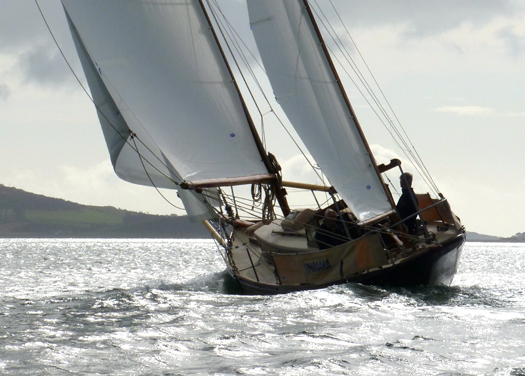
After 94 years, Dickie Gomes's 36ft 1912-built yawl Ainmara (seen here on her home waters of Strangford Lough) hopes to return to defend the title in Howth's Lambay Race, which Ainmara won in 1921 while still in the ownership of her designer-builder John B Kearney. Photo: W M Nixon
The Old Gaffers attention then swings north as the Tall Ships are coming to Belfast from Thursday 2nd July to Sunday 5th July. This is going to be a serious biggie with those ships already signed up including a significant turnout of Class A vessels, which are square riggers and others of more than 40 metres in length. Belfast Lough lends itself particularly well to the Parade of Sail which follows a Tall Ships gathering, and in 2009 when they were last in the port they put in in a virtuoso display with the Dutch ship Europa in particular going to the trouble of getting herself over towards Whiteabbey in the northwest corner of the lough to allow her time get every stitch of sail set before proceeding seawards down-lough in colossal style, a much more impressive display than we've become accustomed to in Dublin, where the shape of Dublin Bay is such that it doesn't really provide the space for square riggers to set all cloth before getting out to sea.
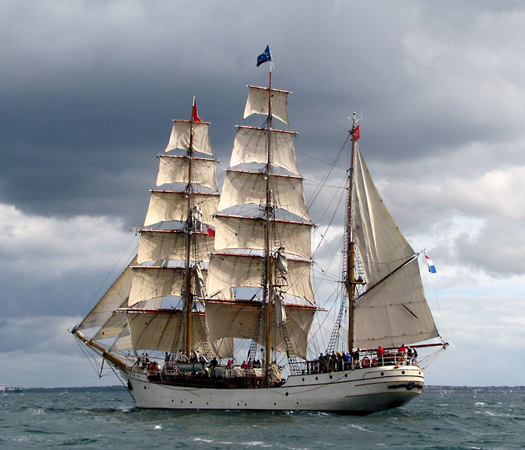
The Tall Ship Europa shows how it should be done in Belfast Lough in 2009, taking time out to set full sail before she starts to gather power to make the proper input into the Parade of Sail.
Like Dublin, Belfast has shown it can be hospitable to Old Gaffers, and it was a very welcoming main port during the OGA Golden Jubilee Cruise-in-Company in 2013, so for 2015 the OGA National President Sean Walsh hopes to up the ante by persuading his members from all round the Irish Sea to gather in Belfast, and to add spice to the mix, he hopes to persuade the Howth 17s to put in an appearance as well, to sail with local one designs like the 1903 Belfast Lough Waverley Class, which have been experiencing a revival in recent years.

Old Gaffers in Belfast for their Golden Jubilee in 2013. The Irish Sea classic and traditional fleet will return to the same venue for the Tall Ships gathering in July 2015. Photo: W M Nixon
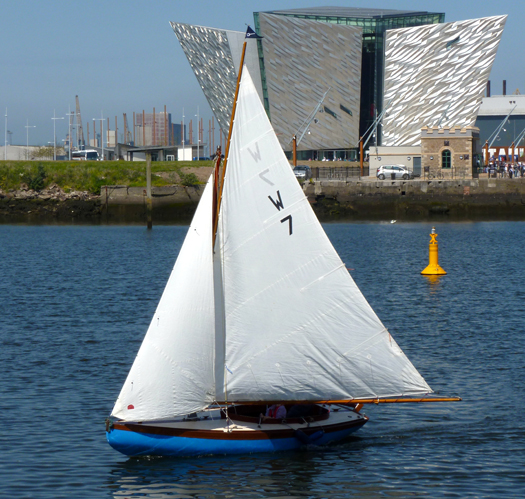
The Belfast Lough Waverley Class Lilias (built 1903) sailing at the Titanic Centre in Belfast. In 2015, the Waverleys will be joined by some of the 117-year-old Howth 17s to participate in the visit of the Tall Ships. Photo: W M Nixon
The Seventeens have made long treks as a class before – in 1998, five of them were road-trailed to Carrickfergus to mark the class's Centenary, with the first five boats built by Hilditch of Carrickfergus. So though they'd trailed there, they then sailed the 90 miles back to Howth, just as the first boats had done a hundred years earlier. Then in July 2003, fifteen of the Seventeens took part in the Glandore Classics Regatta thanks to a brilliantly organised exercise in logistics using a flotilla of low loaders which could take three boats apiece.
For all of Ireland's classic and traditional boats in 2015, and an international fleet too, Glandore is very much up on the radar again, as a special effort is being made by a GHYC team led by Donal Lynch to encourage increased numbers in the CH Marine Glandore Classic Regatta from Saturday July 18th through Friday July 24th. It's a date which certainly allows Old Gaffers plenty of time to get down from Belfast, indeed some may even consider the option of making the voyage northabout to take in a round Ireland cruise while they're at it. And as that great magnet of the Irish Sea classic and traditional scene, the Peel Traditional Boat Weekend, isn't until Friday 31st July to Sunday 2nd August, it's just about possible to factor that in as well.
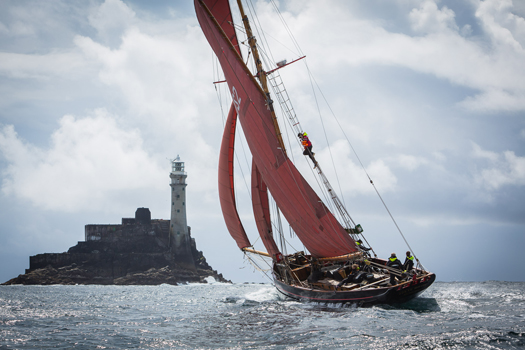
Everything happening at once – the famous Pilot Cutter Jolie Brise was the star of the Glandore Classics in 2013, and as it was her own Centenary she celebrated by sailing round the Fastnet Rock – she has been a successful Fastnet Race participant several times. Photo: Brian Carlin
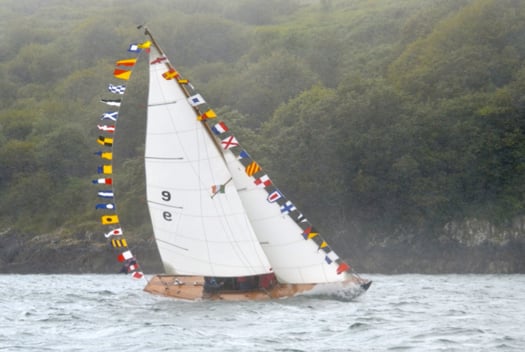
The Glandore Classics attracts an international fleet, and 2013's regatta included a class of Fife One Designs from the Menai Straits, all of them keen to party and showing it. 2015's Glandore Classics is from July 18th to 24th. Photo: Cormac O'Carroll
All this is already happening for the oldies with August barely under way, yet for modern cruiser-racers the potential programme for any keenly-sailed Irish boat is equally complex, attractive and challenging. The season starts as usual with the Scottish Series from Friday 23rd May to Monday 26th May – there'll probably still be snow on the mountains of Arran. They've gone back to their roots by starting with a feeder race from Gourock to the main regatta centre at Tarbert on Loch Fyne. "Going back to the roots" is something of a theme for this year's staging of the Clyde Cruising Club's main racing event, as this is the 40th Scottish Series. Come to think of it, there are so many important 40th anniversaries happening in sailing these days that we have the admit that the decade which brought us the full horror of wide lapels and flared trousers also contributed some lasting elements of the international sailing scene, indeed it could be said that the modern era in sailing really began about forty years ago.
Back in Ireland, the ISORA programme will be well under way by June, while the Lambay Race on June 6th can be looked at with more interest by several boats, as the biennial National YC Dun Laoghaire to Dingle Race doesn't start until Friday June 12th . Last time round, there was a total fixtures clash between the two events, but in times before that hyper-keen sailors such as the Tyrrells of Arklow with Aquelina have been able to fit in both, indeed one year they did it so well they won both too, and were rightly acclaimed as the Afloat "Sailors of the Month" for their success.
For 2015, defending champion in the Dingle Race is Brian O'Sullivan of Tralee with the veteran Oyster 37 Amazing Grace, which came good in the end in 2013 with a new breeze which knocked pending leader Antix (Anthony O'Leary) off the winning perch. But with the 2015 Dingle Race acting as a useful if rather indirect feeder for the Covestone Asset Management Sovereigns Cup in Kinsale from June 24th to 28th, there could be all sorts of sharp boats lining up to take the prize, for the Sovereigns Cup 2015 includes the all-singing all-dancing ICRA Nats 2015.

The welcoming port – Kinsale is one of Ireland's most popular destinations, and in 2015 its hosts the combined Sovereigns /ICRA Nationals from June 24th to 28th.

Perfect sailing – racing in the Sovereigns at Kinsale in June 2013. Photo: Bob Bateman
Yet the timing of the combined Sovereigns/ICRA Nats is such that there's still plenty of time and space to get back to the Irish Sea for the Volvo Dun Laoghaire Regatta 2015 from July 9th to 12th, a reminder that much of the cruiser-racer programme for 2015 is in a neatly balanced and user-friendly timescale for everyone except perhaps those who wish to do either the entire ISORA or SCORA programme as well, so the problem mostly is going to be getting time off work.
And for the hyper-keen cruiser-racers, particularly those whose boats are small enough to be conveniently trailerable, further temptation looms in 2015 with the WIORA Championship at Galway Bay Sailing Club from July 22nd to 25th. For the fleets in the Shannon, on Tralee Bay, and in Clew Bay, it's a bit more than a day's sail away, but they'll be there to challenge Liam Byrne of the home club who won it in 2014 with his Corby 25 Tribal at Mayo SC in Clew Bay, while some top boats from more distant centres are expecting to trail to Galway Bay to spice up the competition.
By this stage of the season a more relaxed pace might be welcome, but the lively turnout of 80 boats in 2014 for the new-style four day Cork Dry Gin Calves Week out of Schull in early August (Tuesday 4th to Friday 7th August in 2015) suggests that for racing sailors, the best relaxation is more racing, but in a holiday setting. And yes, it has been noted that a true West Corkian sailing nut could indeed do all of Calves Week 2015, and still be on the Squadron line for the start of the Fasnet Race nine days later.
For dinghies in 2015, the big story is the debut of the newest version of the National 18, and just how popular will the Bray-bult foiling Moths become, while established classes will frame their programmes to accommodate sailors whose time is limited, also having to fit in with a national scene where the number of Race Officers with the necessary skills is inevitably a finite amount.
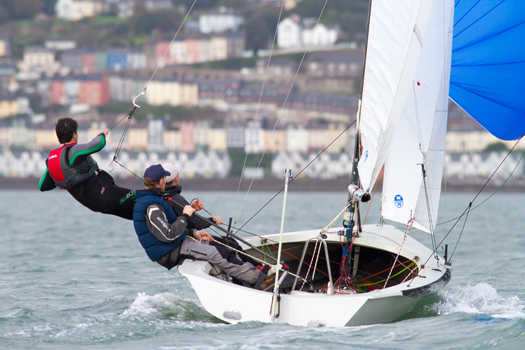
The big stories in Irish dinghy racing in 2015 will be the arrival of the new National 18s at Crosshaven, and the revival of Dinghy Week there in late August. Here, in the Autumn of 2013, To Dwyer and Nin O'Leary test sail the prototype of the new 18 on Cork Harbour. Photo: Bob Bateman
The new Third Generation (or maybe it's fourth or fifth generation) National 18 may have been designed in England by Phil Morrison, and is being built there too. But it was the very active Crosshaven fleet with the Royal Cork Yacht Club which led the charge towards a new boat, and when it came to stepping up to the plate to pay twelve substantial new boat deposits to move it all along after the prototype had been rigorously tested in Cork harbour last Autumn, it was the Crosshaven fleet that provided eight out of those twelve cheques.
So it's entirely appropriate that in August 2015, the dinghy focus will swing big time towards Crosshaven and a short form "Dinghy Week" from August 21st to 23rd. The old style Irish Dinghy Weeks – the last one was in 1970 – became victims of their own success, they just got too large. But the different classes became over-optimistic about their continuing individual growth prospects. Then the pendulum swung too far the other way, and dinghy classes were alone and their events shrinking. But a resurgence of club and championship dinghy sailing in Crosshaven during 2014, and a growing realization that over-reliance on single-handed dinghy classes does not necessarily produce a socially-adjusted national squad of junior sailors, resulted in some clear and creative thinking about developing two-handed boats, and reviving some old classes such as the Mirrors.
The form of this new Dinghy Week is still in the melting pot, but at least eight classes have responded with enthusiasm. Meanwhile, the National 18s in Crosshaven will be such a focus of interest during 2015 with the first of the new boats making their debut that we'll have a season-long dinghy narrative developing on Cork Harbour, and the revived Dinghy Week will be just part of it.
As for inshore keelboats, the big one in terms of number is the combined British and Irish Championship Squib Championship at Howth from 27th June to 3rd July. The handy little Squibs are something of an oddity, as they serve so well as a cherished local class in so many Irish sailing centres that many owners see them as that, and nothing more – handy little club sailors to be raced on home waters a couple of times a week.
This means that when a major regional or national event is held, the number taking part will often only be a fraction of the total Irish Squib fleet. But for those who do make the trek, the competition is fierce and the racing great – in Howth, the high point was in 1996, when this "Nationals" event attracted a fleet of exactly a hundred boats, and on one never-to-be-forgotten morning, there they were, every last one of them on the starting line.

A hundred Squibs all in a row at Howth on Tuesday July 25th 1996. Photo: Mandy Murnane
The most recent Squib event of national stature was the Freshwater Keelboat Regatta at Dromineer on Lough Derg on the weekend of October 18th-19th, and the battle for the top places was between the Kinsale and Belfast Lough fleets, with James Matthews and Rob Jacob of Kinsale rounding out their year in style with a good win.
But with the Squibs in England undergoing a revival – they were the second-biggest One Design fleet in Cowes Week 2014, bested only by the legendary XODs – there's no doubt there's a strong challenge coming across channel, and any Irish boat getting into the top ten will be doing well.
As for that annual Autumn Freshwater Keelboat Regatta at Dromineer, while it may have been much hampered by the spinoff from some ferocious weather out in the Atlantic with frustration for some of the sixty boats hoping to take part, it's an event of enormous potential, and the many who wish it well and have enjoyed it in the past will be ready and willing to do their part to make 2015's regatta a success.

The Squibs enjoying a lull in the strong winds during the Lough Derg Freshwater Regatta 2014. Overall winner was Mucky Duck (no 51, James Matthews & Rob Jacob, Kinsale YC). Photo: Gareth Craig
All these specialised and localized events planned for 2015 will be the continuing background music to the usual events of national sailing focus, everything from the selection of the Irish team for the Student Yachting Worlds to the Helmsmans Championships to the steady increase in pace while 2015 develops as the pre-Olympic year. As the year rolls along, other stories will develop too. So perhaps it's appropriate that we exit this review as we entered it. Just pause to remember now and again that, a hundred years ago, you simply couldn't have gone freely afloat like this for sport and recreation at all.
But we can't close on such a solemn note. Seasoned Solent sailors may have noted our header photo from Guido Cantini at the Panerai Classics Regatta was looking just slightly odd, for some reason difficult to pin down. Well, as it happens, the photo was sent to us back in September just as we were contemplating the excellent cleanup up done by Jason Hurley of Jason Hurley Design on the Mercedes-sponsored billboard photo of Howth 17s on the end wall of Howth Yacht Club. As with many photos taken over the RYS starting cannons, the Cantini pic included an obtrusive part of the Fawley Oil Refinery across on what Isle of Wight people call "the north island". Though Fawley has been there for yonks, it still has the look of a temporary structure. So we got Jason to treat as just that. But here for your edification is the true picture. You could get a taste for this sort of thing. What about brushing out Whitegate, lads? And as for Milford Haven.........
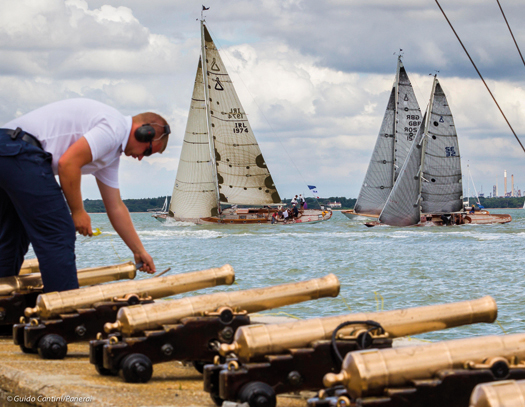
The unvarnished truth. In real life, the view from the RYS battery at Cowes can be slightly marred by the clutter of Fawley Refinery across the Solent on "the north island". Photo: Guido Cantini/Panerai
Read also: 2015 Irish Sailing Fixtures List (provisional)
Victorious Commodore's Cup Team Saluted With ICRA Boat of Year Award
#cruiserracing – Ireland's three boat team that scored the most comprehensive victory in the 22–year history of the Commodores' Cup were saluted in Galway Harbour at the national cruiser conference yesterday when they lifted ICRA's Boat of the Year award. It was a fitting reward for a team that finished the international team regatta on 268 points, with an unprecedented lead of 173.5 points.
The tale of how the 2014 Commodores' Cup was won was related in full by team captain Anthony O'Leary to WM Nixon immediately after the victory here.
The unrivalled performance that saw the team climb to the top of the ranking early in the competition.
Described as one of the most 'clinically focussed keelboat Irish teams', the three boats Antix (Anthony O'Leary), Quokka (Neil Dowling and Michael Boyd) and Mark Glimcher's Catapult left no stone unturned showing total commitment to optimising their boats so they were fully prepared to arrive at the start line in optimum set up.
ICRA contributed by managing to bring to the team the most sought after weather and tidal expert Mike Broughton, who acted as overall team coach at the event. This role was pivotal in maintaining the focus of the team. Supporting the team in Cowes was ICRA flag officers Fintan Cairns, Norbert Reilly and Barry Rose.
Meanwhile, details of the 2015 ICRA Nationals to be sailed in conjunction with Kinsale's Sovereign's Cup were presented to the Galway conference. The 2015 ICRA Notice of Race can be downloaded here.
Irish Sailing Review 2014: A Year Of Hope, Regeneration & Success
#irishsailingreview – 2014 has been the year in which Irish sailing regained its international confidence afloat by re-capturing the Commodore's Cup. Having won it in 2010, the national economic collapse prevented any defence in 2012, but in July 2014 the stain and shame of 2012's non-appearance was emphatically wiped from memory with a convincing team victory led by Anthony O'Leary.
Ashore meanwhile, it had taken longer in some quarters for the economic realities to become fully evident and accepted. But for the Irish Sailing Association, a grassroots revolution within the national authority and sailing in general in 2014 resulted in a root-and-branch analysis of the workings of the Association, which had been heading towards financial disaster through a combination of over-staffing, grandiose schemes of expansion and empire-building, and an emphasis on activities and programmes which were remote from the needs of ordinary sailors throughout Ireland.
It took six months to turn round the course of the Association. But on November 5th 2014 the new ISA President, David Lovegrove, was able to announce a far-reaching re-structuring which is already resulting in a leaner and fitter body, better able to provide a realistic service for clubs and the huge diversity of recreational activity on Ireland's seas and lakes.
While all this high profile activity and action has been taking place at international and national level, those Irish sailors who had managed to keep up their sport through the financial downturn – albeit in often very reduced circumstances – continued to sail their boats with the attitude that, while the economic situation was disastrous, it mustn't be allowed to become serious, and in some ways the best course out of the recession was to sail through it. W M Nixon casts an eye over the year's main activities.
In the Irish sailing year, Christmas Day is New Year's Eve. Next morning, on December 26th – St Stephen's Day or Boxing Day or whatever you're having yourself – the annual 628-mile Sydney-Hobart Race starts. It may be on the other side of the world, and it may still be in the very last days of the old year. But Irish interest at home and in Irish-Australia is always high, and in the sailing community it's seen as the start of the new season.
December 26th 2013 was in line with this, as we'd ex-Pat superstar Gordon Maguire – a previous Hobart race overall winner – very much in contention with Matt Allen's totally new Carkeek 60 Ichi Ban, we also had Sean McCarter of Lough Swilly YC skippering Derry/Londonderry in the warmly-welcomed Clipper Fleet of 70-footers designed by Tony Castro (formerly of Crosshaven) which were taking in the Hobart race as part of their global circumnavigating race, and we'd Barry Hurley and Kenny Rumball on the First 40 Breakthrough knowing that in the 2010 Hobart race, the new design's race debut, First 40s had taken first and second overall.
In a rugged race in which the wind got up to gale force and more towards the end, it was a much-loved hundred footer, Bob Oatley's continually-modified Wild Oats XI, which stole all the headlines with line honours, a course record, and a class win. Irish hopes were best met by Sean McCarter, who logged a very clear win in the Clippers. As for Ichi Ban, while she was third in IRC Div 1 and 8th overall, it wasn't quite a stellar performance, reinforcing the views of those of us who think the boat may be just a little too plump by today's lean and hungry standards. And aboard Breakthrough, they'd 8th in class and 29th overall, a useful performance perhaps, but Barry Hurley will be back on December 26th 2014, boosted by his first in class and second overall in October's Middle Sea Race.
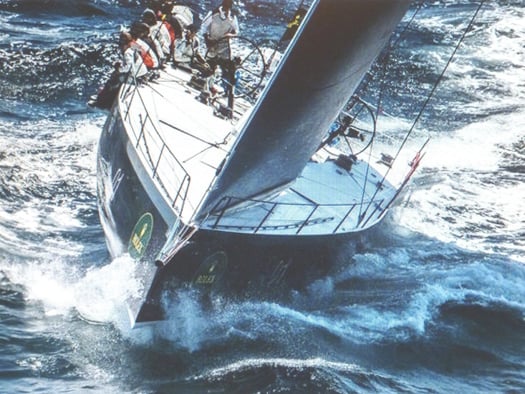
Matt Allen's Ichi Ban in the Rolex Sydney-Hobart Race of 2013, with Gordon Maguire as sailing master. To some observers, the very new Carkeek 60 seemed distinctly plump in her hull form forward compared to her closest competitors
In late January 2014, attention focused on the Quantum Key West Regatta in the Florida Keys, where Irish Olympic sailor Peter O'Leary of Cork was on the strength of New York art dealer Marc Glimcher's completely new and very potent looking Ker 40 Catapult. The boat did the business afloat in Florida, but further business was done ashore, as Anthony O'Leary himself was in Key West to see if he could sign up Catapult to be the secret ingredient in Ireland's Commodore's Cup team, for which at that stage the only certainty was his own older Ker 39 Antix. There seemed to be agreement, but in the volatile world of international trading and snap decisions in which top modern sailing operates, there can be sudden reversals of fortune, and O'Leary later admitted that until Catapult was actually unloaded from a ship in Europe, he hadn't been a hundred per cent certain she'd show.
Key West had further Irish interest in that veteran skipper Piet Vroon's Ker 46 Tonnere de Breskens – a former Round Ireland Race winner – was another star in the show, but much was to happen in Irish sailing before the Round Ireland 2014 got under way in Wicklow on June 28th.
With March slowly showing signs of Spring, university racing came centre stage, and it was University College Dublin which came through on top to qualify as Ireland's representatives in the Student Yachting Worlds in France in October, the team led by Philip Doran.
Another team was emerging as the Irish Cruiser Racing Association (ICRA) announced that our Commodore's Cup squad would be Anthony O'Leary's Ker 39 Antix, Marc Glimcher's Catapult, and the Grand Soleil 43 Quokka chartered by Michael Boyd and Niall Dowling, with Anthony O'Leary as team captain. He in turn would be supported by the shore management team, for a very intense week of racing, of Barry Rose and Fintan Cairns, with Mike Broughton in what would prove to be the particularly onerous task of Team Meteorologist.
As 2014 was exactly midway between two Olympiads, top level international dinghy sailing to Olympic standards might have been expected to be on the back burner. But Ireland's Olympians were very much on track on the international scene, and busy with their own programmes which culminated in the ISAF Worlds in Santander where Olympic places in Rio de Janeiro for 2016 were secured by James Espey in the Laser, Ryan Seaton & Matt McGovern in the 49er, and Annalise Murphy in the Women's Laser Radial. All were of course also seen in other boat types from time to time, with Annalise in particular bringing some glamour to the growing class of foiling Moths in Ireland.
Annalise on the foiling Moth
Other top international women sailors had descended on Ireland in early June with the ISAF Women's Match Race Worlds at Crosshaven. It's very much a specialist sailing interest, but aspiring Irish woman sailors attracted to this discipline found that this successful regatta provided some very useful networking contacts and future crewing possibilities, while the racing itself saw Sweden's Anna Kjellberg of the Royal Gothenburg YC become the new champion after defeating Camilla Ulrikkeholm of Denmark in the final.
In an entirely different area of sailing and life afloat, the traditional boat scene had come early to life with the Baltimore Wooden Boat Festival at the end of May. In the Irish climate after a particularly damp Spring, it reflected great credit on those involved that there was such a good turnout, ranging from the Shannon Gandelows from Limerick recently returned from their historic visit to Venice, through the many restored classic yachts of the region, also including the lovely Shannon cutter Sally O'Keeffe from Kilrush, and going on into the restored traditional mackerel and lobster yawls which make West Cork their home.

Shortly after their historic visit to Venice, the Shannon gandelows built by the Ilen School took part in the Baltimore Wooden Boat Festival at the end of May. The gandelow here, rowed by Liam O'Donghue, Anthony Kenny and Robert Samlle, is headed across Baltimore Harbour towards the gaff ketch Sile a Do.
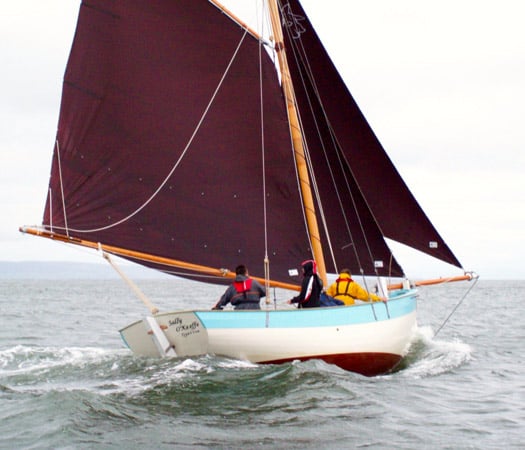
The pride of the Shannon Estuary - Sally O'Keeffe was built in a community effort in Querrin on the Loop Head peninsula.

The traditional lobster boat Saoirse Muireann (left, Cormac Levis) and the mackerel yawl An tiscaire (Uilliam O'Lorcain) are a familiar sight in the waters of West Cork. Photo: Brian Marten
They were to re-appear in even greater numbers at the Ballydehob Gathering of the Boats in early August, a month during which the classic Galway Hookers of the West Coast were at their busiest on their home Atlantic waters, but the East Coast also had its moments with the Riverfest in Dublin's Liffey in early June seeing traditional and classic craft in a lively mix.

Sails in the City – two of the 1898 Howth Seventeens racing in the heart of Dublin in the Liffey Riverfest. Photo: W M Nixon
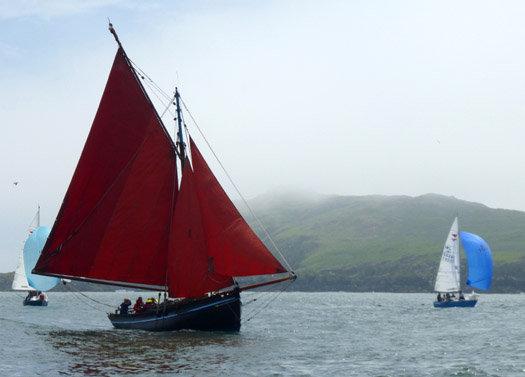
It could almost be Connemara, were it not for the Puppeteer 22s – the Galway Hooker Naomh Cronan in the new Classics & Traditional Division in Howth's annual Lambay Race, which was marking its 110th anniversary in 2014. Photo: W M Nixon
Indeed, so strong is the growing interest in classics and trads on the East Coast that to celebrate the centenary of the Lynch family's Howth 17 Echo (one of the newest of the class, the most senior ones were built in 1898) Howth YC provided a traditional Lambay Race course – simply up around Lambay and back to Howth Harbour – for the Seventeens and a new Classics Division, with the Howth 17s seeing the first two places taken by 1898 boats – Rita (John Curley & Marcus Lynch) and Aura (Ian Malcolm) – while Old Gaffers Association International president Sean Walsh won the classics with his Heard 28 Tir na nOg from the Clondalkin team's Galway Hooker Naomh Cronan. As for the overall prize among the large fleet of more modern boats sailing their more complex course, that was won by Colm Bermingham's Bite the Bullet.
The countdown to the Commodore's Cup had continued with inspirational performances by Anthony O'Leary in the Easter Challenge in the Solent, where he won his class with Antix, and then in June he did the same again with the British IRC Championship. Back home, ICRA held their Nationals with the Royal Irish YC in Dun Laoghaire in mid-June, and out of a fleet of a hundred plus boats it was the vintage Marcus Hutchinson/Rob Humphreys designed Quarter Tonner Quest (Jonathan Skerritt, RIYC) which was best overall scorer, a notably impressive performance also being put in by the Ker 36 Jump Juice (Denise Phelan) from Crosshaven.

The 27-year-old Quarter Tonner Quest (Jonathan Skerritt) was overall winner in the ICRA Nats at the RIYC in Dun Laoghaire. Photo: David O'Brien

Downhill battle at the ICRA Nats with the Mills 36 Raptor (ex-Aztec) in foreground, while beyond is Peter Dunlop of Pwllheli's J/109 Mojito against the XP33 Bon Exemple (Colin Byrne, RIYC). Photo: Davd O'Brien

The Ker 36 Jump Juice (Denise Phelan) dominated Class 0 at the ICRA Nats. Photo: David O'Brien
The end of June, and it was Round Ireland time. Thirty-six boats started from Wicklow, 33 finished in a race which was mostly on the slow side, with mid-size boats having their day. The winner was Richard Harris's Sydney 36 Tanit from Scotland by just six minutes from the home favourite, Liam Shanahan's J/109 Ruth from the NYC in Dun Laoghaire. The French defending champion, Laurent Gouy's Ker 39 Inis Mor which sails in Ireland under the burgee of Clifden Boat Club, placed third while Frank Doyle of Cork, second generation round Ireland aristocracy as son of Denis of Moonduster fame, was fourth with his A35 Endgame.
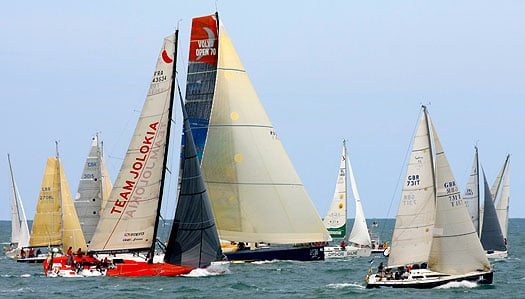
The start of the Round Ireland Race 2014 well illustrates the eclectic nature of the fleet. In right foreground is Richard Harris's Sydney 36 Tanit which was overall winner by just six minutes from the J/109 Ruth (Liam Shanahan), just beyond with the black jib, while the Volvo 70 Monster Project (David Ryan) comes thundering through the fleet at the beginning of a performance whch would see her take line honours win and thd class win in the CK Div.. Photo: Kevin Tracey
The same weekend as the Round Ireland race started, Lough Foyle sent the Clipper Fleet on their way after a week's festivities in Derry/Londonderry, made even more festive by the fact that Sean McCarter and his crew with the home town's boat had crowned their win in the Sydney-Hobart race with victory in the Transatlantic leg to Derry.
Clipper fleet in Derry
Crosshaven fairly leaped to life with Cork Week in July, and after several hitches in various boat-shipping plans, it was notable as the first time the Irish Commodore's Cup Team 2014 were seen together, and mighty impressive they looked too, with Quokka proving best on the Cork Week leaderboard.
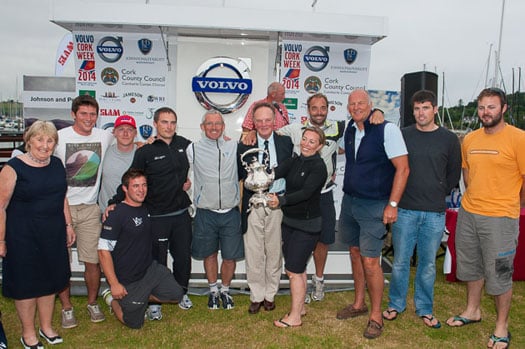
Michael Boyd (centre behind cup) and his Quokka crew, a member of Ireland's Commodore's Cup team, were overall winners of Cork week 2014. Photo: Bob Bateman
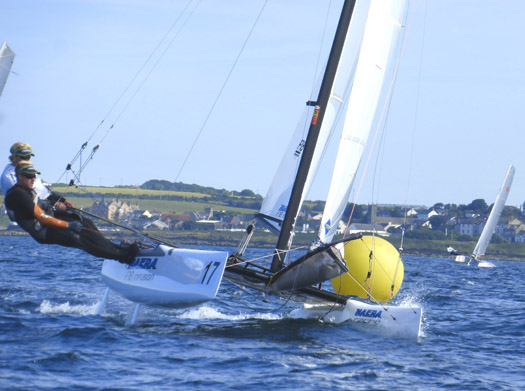
In the F18 Worlds at Ballyholme, Dutch skipper Gunnar Larssen (crewed by Ferdinand van West) is seen here putting in the smooth performance which saw him winning the worlds at his thirteenth attempt. Photo: W M Nixon
While all this excitement in racing boats with lids was building on the south coast in July, up north on Belfast Lough at Ballyholme the F18 Worlds were held for one of global sailing's most popular catamaran classes. Though the entry of 56 boats didn't match the 150-plus entries they get when the class has its worlds in its Mediterranean heartlands, the sailing was good and a popular winner emerged in longtime F18 sailor Gunnar Larsen, who is Dutch despite his Scandinavian name.
Dinghy attention was also very closely focused on Dublin Bay, with an enormous fleet of Optimists at the Europeans hosted by Royal St George YC from 12th to 20th July, and Dun Laoghaire really showing what it can do in being a major international regatta centre. France's Enzo Balanger was tops from Sweden's Kasper Nordenram, while best of the Irish in the Gold Division was Royal Cork's James McCann in tenth – not surprisingly, he was to go on to win the Nationals at his home club in August.

Nations from across Europe and beyond were at the Optimist Euros at Dun Laoghaire

Finn Lynch racing at Douarnenez in France where be became the new U19 Laser Standard world championPhoto: Trevor Millar/Sail Coach
On the broader international scene, former Opty stars Finn Lynch (National YC) and Seafra Guifoyle (Royal Cork) were to turn in outstanding results during 2014, with Guilfoyle firmly in the frame through the ISAF Youth Worlds in the Laser, eventually coming home from Tavira in Portugal with the Silver, while Finn Lynch was on top form to clinch the Gold in the Under 19 Laser Standard Worlds at Douarnenez in Brittany.
Back aboard the boats with lids, late July had brought the Commodore's Cup in the Solent, and if anyone out there doesn't know who won, we'd like to hear from them, as the state of total seclusion which this implies is surely something which could be packaged and marketed to our hyper-informed and over-crowded world. The comprehensive Irish victory just seems better and better with the passage of time, and for Anthony O'Leary it was the highlight of a fantastic season which in September was to see him win the Helmsman's Championship of Ireland (admittedly by just a whisker) in J/80s in Howth to set up a national double for Royal Cork, as young Harry Durcan of Crosshaven was winner of the Junior Helmsmans. O'Leary meanwhile went on to win the 1720 Nationals in Baltimore later that month, and then in November his beloved Antix was named RORC Yacht of the Year.

Antix in the Commodore's Cup, hanging in well coming to the weather mark to stay ahead of the newer Ker 40 Cutting Edge. Photo: Rick Tomlinson)
Even as Antix and her team mates were racing on towards glory in the Solent, in Clew Bay the West of Ireland Offshore Racing Association (WIORA) were staging their annual championship at hospitable Mayo SC, and it saw a good spread of results, with the overall winner being Galway's Liam Burke with his Corby 25 Tribal, while the runner-up was the McGibneys' Dehler Optimum 101 Dis-a-Ray, which sails under the Foynes YC burgee, but her home port is Tarbert further west along the Shannon Estuary.
August was busy with events for enjoyment. Eighty boats raced in Calves Week in West Cork, which has now been compressed to a four day regatta which means, as one sage family man observed, that you can take a house in Schull for a week's holiday, and then just as the wife and kids are getting fed up with having the ould fella always about the place, doesn't he absolutely have to go off and spend the last four days of the holiday sailing with his mates? That one of the top boats was Colman Garvey's True Penance maybe says it all.

Calves Week 2014 entries were up 25% in 2014. Photo: Bob Bateman

The GP14 Worlds at East Down YC in Strangford Lough launched a hundred boats every day in smooth style. Photo: W M Nixon
The biggest dinghy event of all (other than the Laser Nationals, which as ever are in a league of their own) was the GP 14 Worlds in mid-August at East Down YC in Strangford Lough, which had its excitement in a sudden storm on the Monday, but it all turned out okay. Boats involved were just over the hundred mark, the best boats were built in Northern Ireland by Alistair Duffin, and winners were English crew of Ian Dobson and Andy Tunnicliffe from Burwain, while top Irish were John and Donal McGuinness of Moville in Donegal, they were sixth.
At the other end of the intensity scale, down in Howth they had their first cruiser-racer two-hander for the Aqua Restaurant Challenge. Despite very restrained pre-publicity, it attracted 34 boats for a race round Lambay and the Kish. Stephen O'Flaherty's elegant Spirit 54 Soufriere, fresh from a win in the Panerai Classics in Cowes and co-sailed by David Cagney, took line honours and almost won, but the vintage Humphreys Half Tonner Harmony (Peter Freyne and Jonny Swann) just pipped them at the end.
Sailed in summery weather, the new Howth two-handed was about as different as possible from another two-handed experience in August, that of Liam Coyne (NYC) and Brin Flahive (Wicklow) in the 1800 mile RORC Seven Star Round Britain and Ireland. They didn't have to be two-handed, there were fully crew boats involved including the 70ft–trimaran Musandam in which Ireland's Damian Foxall played a leading role in taking line honours in record time, but aboard the First 36.7 Lula Belle the Irish duo just toughed it out despite sailing the last 500 miles with virtually nothing functional, they simply decided to see it through, and to their amazement found they'd won Classes V & VI.
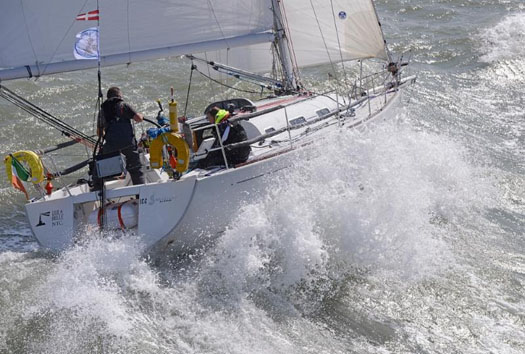
Lula Belle on her way out of the Solent with 1800 miles to race. Photo: Rick Tomlinson
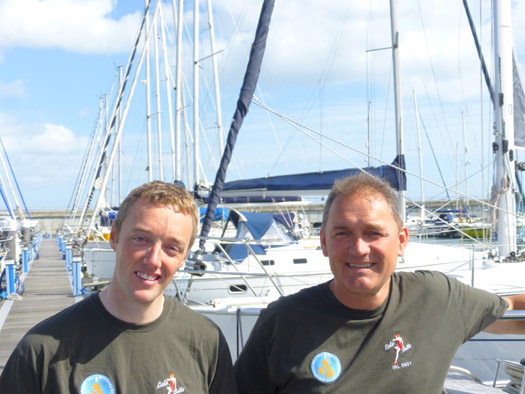
Brian Flahive & Liam Coyne back in Dun Laoghaire on the morning of their return from the finish of the Round Britain & Ireland Race. Photo: W M Nixon
As for the Laser Nats, they were at the end of August and another Ballyholme event, with Johnny Durcan of Royal Cork winning from Rory Fekkes of the home club, while the radials saw Annalise Murphy keep her hand in with a win from Cork's Cian Byrne.
After some rugged August weather, particularly on Ireland's East Coast, September was utterly blissful and it sweetly rounded out Dublin Bay Sailing Club's 130th season, the birthday being marked by a fairly epic dinner in the National YC. September also saw the conclusion of the slowly but steadily reviving Irish Sea Offshore Racing programme, with the end-of-season race from Pwllheli to Dun Laoghaire seeing Liam Shanahan's J/109 Ruth confirmed as the overall winner of the series. Among locally campaigned dinghies, meanwhile, Dun Laoghaire's keen Fireball Class kept its annual programme in lively shape, and the season drew a close with Barry McCartin and Conor Kinsella winning overall from Noel Butler and Stephen Oram.

ISORA Champion Ruth skippered by Liam Shanahan jnr from the National Yacht Club
Across country in Limerick, the CityOne dinghies and the traditional Shannon gandelows created in projects of the Ilen Boatbuilding School made their debut in the city centre on one of the last days of the Indian summer, and then they were put on display in a Naumachia in St Mary's Cathedral which was officially opened by Michael Noonan TD, and later formally visited by President Higgins.
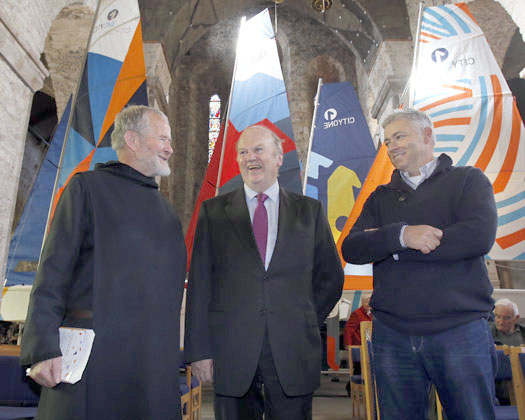
The hopeful new spirit of Irish sailing in 2014 was evident in St Mary's Cathedral in Limerick, when the CityOne dinghies built by volunteers in an inner city revitalisation project went on display in a Naumachia in the Cathedral on September 26th, after their first regatta on the Shannon in the heart of Ireland's City of Culture 2014. With the boats in the cathedral were (left) Brother Anthony Keane of Glenstal Abbey (Director, the Ilen School), Limerick's senior TD and Ireland's Minister for Finance Michael Noonan, and Gary MacMahon (right) Director of the Ilen School & Network for Wooden Boatbuilding. Photo: Press22
And then more vigorous winds returned in October, with the Freshwater Keelboat event on Lough Derg – originally just an exclusive Dragon thing – finding itself swamped with sixty and more boats from five classes and increasingly rugged conditions, such that only the Dragons and Squibs managed to get in any meaningful racing, with Neil Hegarty (RStGYC) winning the Dragons while James Matthews and Rob Jacob of Kinsale topped the Squibs.

Dragons in Autumn action on Lough Derg – Neil Hegarty (right) was overall winner from runner-up Richard Goodbody (left) Photo: Gareth Craig
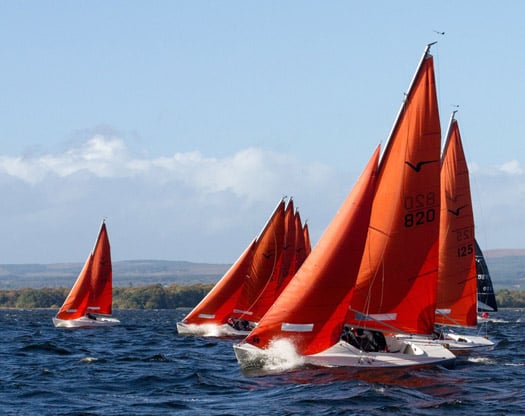
Squibs on Lough Derg – it may look like perfect sailing, but the top came off the weather very soon afterwads. Photo: Gareth Craig
The Student Yachting Worlds in La Rochelle in October had some hiccups in UCD's campaign for Ireland, but while they very narrowly missed the podium in a truly international event, they stayed put at fourth overall. And round in the Mediterranean, a record fleet for the Rolex Middle Sea Race from Malta saw entries soar through the 120 mark for the first time, and the 606 mile race had its first half in light breezes, but the second half was in pure Mistral, with people talking of "winds easing to 44 knots....." A Maltese-owned J/122 won, but second overall and first in her class was the Xp44 XpAct (Josef Schultheis) with a strong Irish emphasis in her crew including Barry Hurley, Andy Boyle, Kenny Rumball and Phillip Connor.
Soon afterwards, the Volvo World Race got under way with first stage from the Med to Cape Town, and Ireland's Justin Slattery on the winning boat on Leg 1. Back home, Autumn leagues had seen renewed enthusiasm as though people had suddenly re-discovered their sport, and the great sailing year of 2014 drew towards its close with the Lasers in Howth starting their 40th winter of annual frostbite racing. This means that HYC have now had a continuous sailing programme since April 1974, while across in Dun Laoghaire the DMYC Frostbite Series must be the most senior of all winter events. Winter Leagues attract more aficionados, with the popularity of the Dublin Bay Turkey Shoot in particular providing a forceful reminder that Dun Laoghaire is the principal sea access for a notably affluent and very large population in South Dublin. With the Turkey on its way, soon it's Christmas. And then the new Irish sailing season will begin on the blue waters of Sydney Harbour.
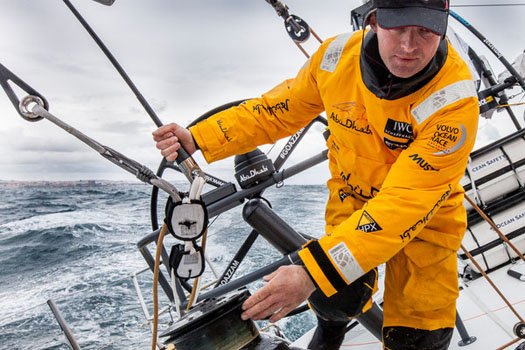
Justin Slattery on Volvo World Race 2014. Photo: Volvo Ocean Race
Royal Cork Yacht Club Welcomes Home the Commodores' Cup
#rorcbdcc – It was a night of pride, joy and no little emotion at Royal Cork Yacht Club as winning Commodores' Cup captain Anthony O'Leary brought the Cup home to Crosshaven writes Claire Bateman.
Last night was the occasion for Anthony O'Leary to return, for the second time to his home base, the magnificent Commodores' Cup first won in 2010.
Admiral Pat Lyons, members of the Executive Committee, members and staff were on hand to join in with the enthusiastic welcome accorded to the Irish team members present and the Admiral accepted the presentation of the Commodores' Cup to display where all can admire this beautiful trophy.
Also joining in the celebrations were Norbert Reilly, Commodore, Irish Cruiser Racing Association and David Lovegrove, ISA President.
The gathering enjoyed a drinks and finger food reception before going on to the official part of the evening.
Admiral Lyons in his welcome and congratulatory speech welcomed everyone and was proud to illustrate how sailing develops from the youngest members in their Optimist dinghies right through the ranks to the ultimate accolades at the highest end of sailing.
He also pointed out that of the thirty one members of the Irish winning team at Cowes no less than fourteen of them were from the Royal Cork Yacht Club and said he would like to emphasize it was not just the winning of the event but the manner in whicb it was accomplished with a tremendous margin of almost 175 points.
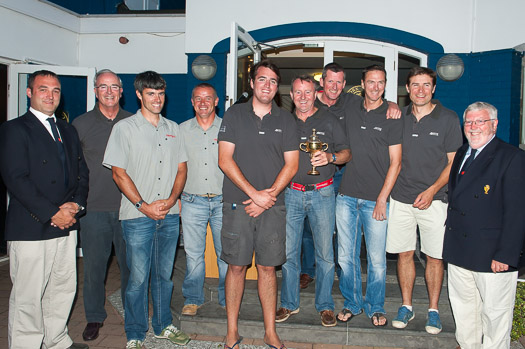
Happy crew – members of the Commodores' Cup team are welcomed home by Admiral Pat Lyons (right) and RCYC flag officers. From left to right are: Kieran O'Connell Rear Admiral Keelboats, Anthony O'Leary, Peter O'Leary, Alan Curran, Robert O'Leary, Dan O'Donovan,Tom Durcan, Clive O'Shea, Derek Moynan Photo: Bob Bateman
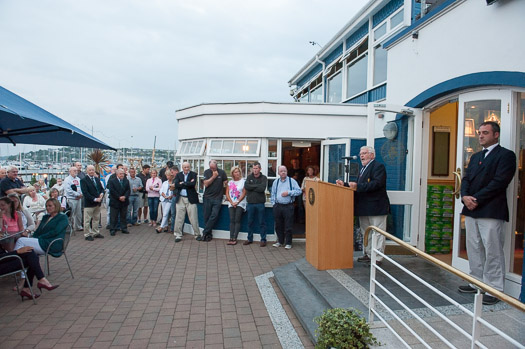
Royal Cork turns out to welcome home the cup. Photo: Bob Bateman
In his reply Team Captain Anthony O'Leary endorsed the Admiral's comments regarding junior sailing and none better to do this as he has been involved in the promotion of the juniors since the early nineties and especially in the promotion of Optimist sailing. He then went on to give due credit to the other team skippers of the Irish Team, Marc Glimcher from the United States. He mentioned that Marc had added Patrick to his name during the week to assert his Irishness.
He then went on to explain the difficulties experienced by the co-charterers of Quokka 8, Michael Boyd and Niall Dowling, in trying to overcome delays in having the boat returned from the Carribeann and the magnificent effort they put into chartering other boats to work up with the squad while awaiting Quokka's return and one can only marvel at the results obtained.

Team Captain Anthony O'Leary (left) hands the Cup over to Admiral Lyons. Photo: Bob Bateman
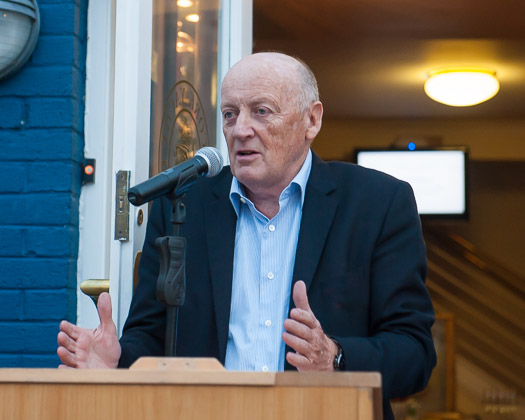
ICRA Commodore Norbert Reilly
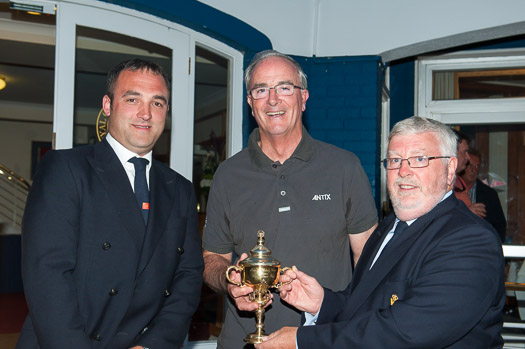
ICRA Commodore Norbert Reillly spoke and told of the astonishment of the other teams at how the event was won. Where the other countries had boats for heavy weather, light weather and where we had a Ker 40 they had two Ker 40s. Where Ireland had a Grand Soleil, they had a Grand Soleil and where we had a Ker 39 they had a Ker 39 and he jokingly mentioned that he was sure Ker 39's would now treble in value throughout the yachting world which resulted in a round of applause and cheers. Commodore Reilly didn't miss a trick and also pointed out that the Irish had "cleaned out all the other trophies at the Commodores' Cup event".
Following the finish of the official welcome home, the prize giving took place for the final night of the Marshall Marine League.
TOMORROW ON AFLOAT.IE
THE COMMODORE¹S CUP – HOW IRELAND WON IT, AND WHERE IT MIGHT GO FROM HERE
Tomorrow in Afloat.ie's Sailing on Saturday blog W M Nixon meets winning Team Captain Anthony O'Leary for a free-ranging discussion about Ireland¹s convincing international victory in the Brewin Dolphin Commodore¹s Cup, how it was done and what the future could bring. Click HERE.
#rorcbdcc – The nine teams contesting the Brewin Dolphin Commodores' Cup are currently racing round the Isle of Wight on the penultimate day of the seven day event in Cowes, Isle of Wight.
Ireland's team competing for the Commodores' Cup in Cowes stand on the brink of success this weekend as the 31 sailors have built an impressive 100-point overall lead.
The winner of the Commodores' Cup will be announced at the prizegiving for teams from Ireland, Britain, Scotland and France tomorrow after the final race. Ireland has a 100–point lead but anything can happen in these last crucial stages.
#rorcbdcc – The Commodores' Cup offshore race is over and Ireland still tops the leaderboard writes Barry Rose in Cowes. Results attached for download below.
It turned out to be a fetch out of Solent with code zeros being hoisted up and down as wind shifted. The Irish boats were all well positioned heading out of Solent
Fleet compressed a little on run to leeward gate 50 miles towards Cherbourg Long upwind leg on return turned to a beat at end of Island in falling breeze and turning tide so tricky finish as expected.
Catapult took line honours and finished third which was a great result. Conditions favoured the big boats and she took full advantage sailing a sound tactical race to the finish.
Antix also sailed very well to achieve her position finishing 20 th as she was in the complex slot between the first and second groups when the compression occurred. She again sailed tactically smart approaching the finish which was the only opportunity to make gains.
Quokka sailed a strong race from start to finish and again took maximum advantage when only tactical opportunity arose towards the end.
All in all a really good team performance from the Irish boats to keep the team top of the leader board.
The French teams Green and Blue as expected were very strong in offshore with radical looking boat Teasing Machine providing a flyer in the conditions to record a win.
No racing today and a single inshore tomorrow. All to play for!
Additional report from James Boyd/RORC:
Stronger winds and reaching conditions resulted in a shorter than anticipated offshore race that allowed crews to sleep in their own beds rather than spending a night at sea in the highest scoring race of the Royal Ocean Racing Club's Brewin Dolphin Commodores' Cup.
The course took the boats west out of the Solent, southeast down to a virtual gate 26 miles northeast of the Cherbourg peninsula, returning north to the New Grounds Buoy off the Nab Tower, then west to Bembridge Ledge buoy before a final beat to the finish line, just south of Gosport's Gilkicker Point.
The wind being further west and stronger than forecast resulted in a fast reach down to the virtual gate and it was the powerful reaching machines such as the Ker 40s and the brand new French Archambault A 13, Teasing Machine, that relished the conditions.
"We had 20 knots - a good five knots more than forecast," recounted Nick Cherry, one of the two 'pros' on Robert Lutener's Ker 40, Cutting Edge, sailing in GBR Red. "We even had a mini broach out on the changeovers between helms. We were on the hottest angle we could hold the A2."
As forecast, the wind did drop and veer into the north as the boats sailed back towards the Nab Tower, but it never disappeared altogether and pre-race fears of a midnight park-up off Bembridge proved unfounded.
Among the Ker 40s, the first boat home was the 'turbo-ed' Catapult of the Irish team, finishing at 22:26:32 BST. "It was a very nice race, a Ker 40 race, which is always fun," said American owner Marc Glimcher. "We messed with each other a little bit on the upwind which was enjoyable." In the final legs to the east of the Isle of Wight, before the finish, the wind dropped off to five knots momentarily but, as Glimcher put it: "It was a lot easier than we thought. We did not get stung."
Marc Glimcher has brought Catapult over to Europe to join the Irish team from her usual base in Newport, Rhode Island. "It is fantastic. I have been hearing about this event for many years. This seemed like serious racing to us and it is very exciting. And the team racing side - you can screw it up and someone else can come to the rescue!" said Glimcher.
While the three Ker 40s claimed most of the top spots, the outright winner of the offshore race was Eric de Turkheim's mini VO70-like Teasing Machine, which finished 2 minutes 6 seconds ahead of Cutting Edge on corrected time. The delighted owner, Eric de Turkheim, commented: "We got the boat on 20th June and we've done very little testing in terms of speed and set-up, so today was very good because we had no idea of what our speed would be versus the Ker 40. Fortunately it was good enough..."
He praised his navigator, leading French Figaro sailor Gerard Veniard. "Gerard did an excellent job on the way down and on the way back, when we sailed fairly high knowing that it could be a bit tricky at the end."
According to Veniard, en route to the Nab Tower mark they saw the wind drop from 17 knots to 7 and veering from 275 to 345°, as their shore based routing expert Christian Dumard had predicted, but the wind had been more consistent than forecast.
"We call the boat 'fat booty'," said Veniard, nodding towards Teasing Machine's powerful transom. "From the beginning we thought that the race was ours because there was a lot of reaching. It was tactical - on the two long legs, it looked like straight line, but it was not. We sailed 7-8° higher and there was more wind on the west side coming back."
While there were fears for the smaller boats, with the wind forecast to drop and the tide turning foul, in fact the last boat to finish, Iain Kirkpatrick's X-37, Fatjax, did so at 01:54:18.
Generally the boats suffering most were those better at windward-leewards, such as Anthony O'Leary's Ker 39, Antix; the winner of both Sunday's inshore races finished in an uncharacteristic 20th position. Despite this and the offshore race carrying a 2.5x co-efficient, thanks to the performance of her team mates, Catapult, and Michael Boyd and Niall Dowling's Grand Soleil 43, Quokka 8, Ireland has retained her overall team lead.
A similar type boat to Antix was James Neville's Corby 36, INO, racing in GBR White, which also struggled on the reach down to the virtual gate. As navigator Nat Ives described it: "We were looking forward to the run, but there was very little running, it was quite reachy from the start. So that leg was really difficult for us with our lack of form stability on a relatively tight spinnaker leg. We were sailing at 100% of our polars, but the J/109s were going quicker."
Thankfully, according to Ives, they pulled a bad result out of what would have otherwise been a terrible one between the virtual gate and the finish, initially setting up to the east where there was better wind for the smaller boats. "We were sailing the boat well there and we started to claw back into boats, people like Yeoman of Wight, which we overtook there and the Farr 30 [Eric Basset's Motivé in France Green] which had flown down from the Needles."
Later INO won out by not going into the shore at Bembridge, where the foul tide was stronger. "We sailed solidly then and a lot of the boats around us were slow, so we picked off six or seven boats in the last piece from New Ground up to the finish," concluded Ives.
Racing at the Brewin Dolphin Commodores' Cup continues tomorrow (Wednesday) with one inshore race.
Commodores' Cuppers Face Tactical Night at Sea
#rorcbdcc – Variety has always been the spice of the Brewin Dolphin Commodores' Cup with the 27 boats from France, Scotland, Ireland and England this week getting to sail a mix of inshores, offshores and a race around the Isle of Wight writes James Boyd. At 09:30 BST today the fleet of three boat teams set sail from the Royal Yacht Squadron line of Cowes on the 'offshore race', longest and most high scoring of the series.
The latest (1900hrs) on the Irish team from the race course via the yellowbrock tracker HERE is Catapult up there (6th), Antix (22) and Quokka (14), a mid to deep scenario but very much a fluid one.
In Cowes, with the Irish team, ICRA's Barry Rose told Afloat.ie (at 20.45): 'Four bigger boats including Catapult have eased ahead of the main fleet which is in turn led by another group that includes Ireland's Antix and team-mate Quokka 8. Predictions for the first finishers range from 2230 this evening to 0700 tomorrow morning'.
With a moderate wind forecast and the wind due to shut down tomorrow, the Race Committee, led by former Etchells World Champion Stuart Childerley, worked hard to set a fair but challenging course. They opted to send the boats west out of the Solent, passing the Needles Fairway buoy then down to a 'virtual mark' mid-Channel, before returning north to the New Grounds Buoy off the Nab Tower, then on to the Bembridge Ledge buoy and leaving No Man's Land Fort to port before the finish line south of Gosport's Gilkicker Point.
After a long starboard gybe in 10-15 knot WNWerly wind, at 1600 BST the first boats were rounding the virtual gate. At the front of the fleet the beamy Ker 40s were loving the conditions. GBR Red's Cutting Edge and GBR White's Hooligan VII had done a good job of fending off the 'turboed' and higher rating Catapult, leading the Irish boat around the gate.
They were followed 10 minutes later by Eric De Turkheim's radical A13 Teasing Machine, sailing for France Green followed at around 16:30 by GBR Scotland big boat, James McGarry's Swan 45 Eala of Rhu. A gaggle of smaller boats, with yesterday's double winner, Anthony O'Leary's Ker 39 Antix, in front rounded the mark some 20 minutes later.
While so far the race has not been overly tactical, this evening it will become so. The boats will head north on port tack in a westerly breeze but around seven miles short of the New Grounds Buoy, the wind is forecast to start veering into the NNW and dropping substantially. This new breeze is expected to edge south through the evening meaning that the smaller boats will end up spending more time directly on the wind than the bigger boats. The wind is then likely to peter out completely on the race course around midnight, further favouring the big boats who's crews will be gunning to have finished and be on their way back to Cowes before this happens.
Figaro sailor and multiple Match Racing National Champion Nick Cherry, who is racing as one of the Group 3 'pros' on board Robert Lutener's Ker 40 Cutting Edge in GBR Red, leading the race at 17:45 BST, predicted of the latter stage of the race: "It will be a two sail fetch back up to the Island and that is where it will get interesting. Our best routing has us finishing at 10.30 tonight, before the pubs shut! But that relies on it not dropping to 5-6 knots off Bembridge. The likelihood is that we will sail into a park-up and end up sitting for a few hours at the buoy near Nab Tower. I think that is where the race will get decided.
"I think it will favour big boats, because if you weren't going to finish until later in the morning, there won't be a sea breeze until later on tomorrow. The small boats could really get their pants pulled down."
Past President of the Union Nationale pour la Course au Large, Marc de San Denis, racing on the Prietz family's A-40 Goa in France Blue, predicted a finish time of 0700 tomorrow. He commented: "It is an interesting quite clever course, with a long reach and then going upwind. We hope that the wind shift is late enough, otherwise the big boats could have an advantage steering directly back to Bembridge. Ideally it will go north when we are at Bembridge - that's what we've ordered!"
After the whipping the French gave the rest of the fleet in last year's Rolex Fastnet Race, the 12-strong French line-up is hoping to repeat their success in this year's Brewin Dolphin Commodores' Cup.
The crew on the Guoy family's Ker 39, Inis Mor, had been hoping for a longer offshore race. "We are very pleased to be here, but not pleased with our result yesterday!" said son Laurent. "Obviously we have been focussed on the offshores for the last two or three years and we always have some difficulties in the Solent."
Of tonight's grande finale Gouy predicted: "The wind will decrease quite a lot and with the tide arriving, the guys ahead will be more lucky than the guys behind. It will be about playing with the tide and the dying wind." The pre-race routing had Inis Mor reaching the mark off Bembridge at 22:30-23:00 BST tonight. "The 10 miles will be in very little wind and with the tide against us," warned Gouy.
Facing a long night was David Aisher, who is working the pit on board his J/109 Yeoman of Wight in GBR Blue, at 17:45 BST lying second overall. Prior to leaving Cowes Yacht Haven this morning the past Commodore of the RORC was keeping his fingers crossed that the wind would shut off later tonight rather than earlier. "If it shuts off when it says, then everyone should be home. But if it shuts off early I think the big boats will get in and the little boat will be stuck out and struggling to get in late morning. We'll just have to sail faster!"



























